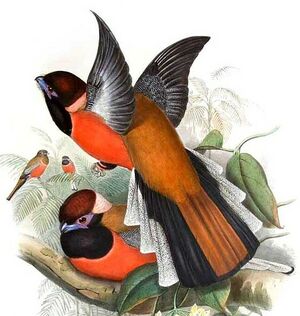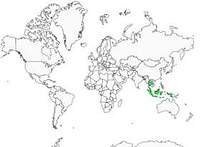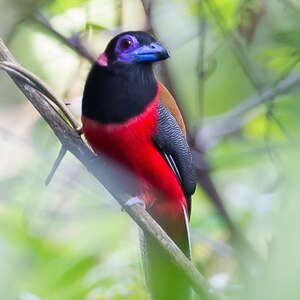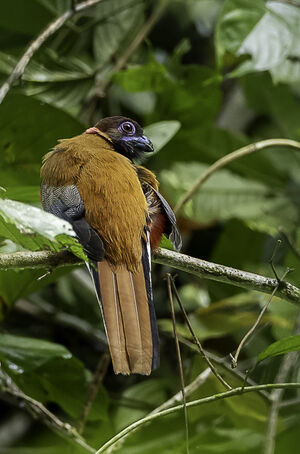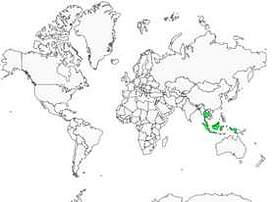Diard's Trogon
Harpactes diardii - Trogon de Diard
Identification
When Pierre Médard Diard (1794-1863) and Alfred Duvaucel (1793-1825) left for India, our two French ornithologists did not know they would give their names to two of the most beautiful Asian trogons: Duvaucel's Trogon and Diard's Trogon. Pierre Médard Diard traveled extensively in Asia; he became one of the first Europeans to see Angkor, and while working for the Dutch he sent his collections to Jacob Temminck (1778-1858), who honored him by naming our trogon after him. A large trogon of 34 cm with a distinct dimorphism, the male has a strong pale blue bill with a black tip surrounded by very visible bristles. The forehead is dark brown, almost black, above the bill; chin, throat, and upper chest are black. The crown and nape are brown, the iris is brown-red with an unmistakable cobalt blue orbital ring. The eye is surrounded by a protuberance of pinkish-violet skin that also frames the base of the bill; a thin pink band divides the black chest from the scarlet belly, the scapulars remain brown-striated, coverts are finely barred black and white, flight feathers are black with distinct white margins. The outer rectrices are white, finely barred black - this is a distinguishing characteristic of the species, as Diard's Trogon is the only Harpactes trogon to have these markings on the tail; the central rectrices are brown-striated, barred black at their tips. The female maintains the same cobalt blue bill with a black tip and brown-red iris surrounded by a blue orbital ring. The eye, as in the male, is framed by the same pinkish-violet protuberance. Forehead, crown, nape, throat, and chest are brown, mantle is brown turning to brown-striated on back and rump.The female does not have the pink half-collar on the back; a brown-yellow band separates the chest from the pale red belly, almost pink on the lower belly; the coverts are dark brown and buff-coloured, the primary remiges remain dark brown and the emarginations are not white but light buff-coloured. The outer rectrices are identical, wihte and black vermiculated, the central rectrices adopt the brownish-chestnut colour of the back. The tarses are grey-mauve. The juveniles look like their mother, the belly does not have the red colour of the adults yet, it is light brown spotted with white. Two subspecies, Diard's Trogon ssp diardii described previously and ssp sumatransus, the male has a black head and only a small brown mark on the neck, the skin protrusion around the eye is more violet than pink, the mantle and the back have a lighter brown shade than the nominal species; the female is similar to the female diardii.
Subspecific information 2 subspecies
- Harpactes diardii diardii (Borneo and Bangka I.)
- Harpactes diardii sumatranus (Malay Pen. and Sumatra)
Foreign names
- Trogon de Diard,
- Trogón de Diard,
- republicano-de-olho-violeta,
- Diardtrogon,
- bíborhasú malájtrogon,
- Diards Trogon,
- Trogone di Diard,
- diardtrogon,
- Rosenringtrogon,
- dravčík obojkový,
- trogon Diardův,
- Brunnakket Trogon,
- pitsipyrstötrogoni,
- trogon de Diard,
- sędzioł obrożny,
- Ожерелковый азиатский трогон,
- Luntur diard,
- バラエリキヌバネドリ,
- 紫顶咬鹃,
- นกขุนแผนหัวดำ,
- 紫頂咬鵑,
Voice song and call
Habitat
Rarely found above 1,200 meters, Diard's Trogon frequents primary forests and forest edges of secondary forests. Like its cousin Duvaucel's Trogon, it prefers specific dipterocarp forests in Indonesia and Malaysia with very tall trees (reaching 70 m) while staying at altitudes of 20 to 30 m. It can also be seen near coconut plantations or bamboo groves.
Behaviour character trait
Exclusively sedentary.
Dietfeeding habits
The majority of its diet consists of insects (phasers, flying ants, orthopterans, beetles, caterpillars, different larvae, termites). It is often seen hunting from a perch. Its diet is supplemented by fruits, such as those from various Ficus species.
Reproduction nesting
From February to mid-May in the Malay Peninsula and from February to May, possibly September to Borneo, Diard's Trogon breeds. It digs its nest in an old low trunk (1.20m to 3m), the entrance having a diameter of about 12 cm, and a pair give birth to a clutch of two eggs. No real observation has been made on the breeding of Diard's Trogon.
Geographic range
Threats - protection
IUCN conservation status
concern
in the Wild
threatened
evaluated
The Diard's Trogon is classified as Near Threatened, and is suffering from deforestation and population growth. Parks and reserves still provide havens of peace for the trogon, but will this be enough?
Sources of information
- IOC World Bird List (v15.1), Gill, F and D Donsker (Eds). 2025-12-07.
- A Natural history of the Trogonidae, Joseph M.Forshaw Albert Earl Gilbert
- Vol. 6 - Handbook of the Birds of the World, Josep del Hoyo-Andrew Elliott-Jordi Sargatal
- xeno-canto, Sharing bird sounds from around the world,
- ARKive, Christopher Parsons
- BirdLife International, BirdLife International
- HBW Alive,
- Oriental Bird Club,
- Wikipédia, Wikipedia, The Free Encyclopedia
- Scientific Birds Names, James A.Jobling
- The internet Bird Collection,
Other sources of interest
 Specification sheet created on
04/08/2023 by Anne et Gabriel Leboff
Specification sheet created on
04/08/2023 by Anne et Gabriel LeboffTranslation by AI Oiseaux.net
© 1996-2025 Oiseaux.net
- Accipitriformes
- Aegotheliformes
- Anseriformes
- Apodiformes
- Apterygiformes
- Bucerotiformes
- Caprimulgiformes
- Cariamiformes
- Casuariiformes
- Charadriiformes
- Ciconiiformes
- Coliiformes
- Columbiformes
- Coraciiformes
- Cuculiformes
- Eurypygiformes
- Falconiformes
- Galliformes
- Gaviiformes
- Gruiformes
- Leptosomiformes
- Mesitornithiformes
- Musophagiformes
- Nyctibiiformes
- Opisthocomiformes
- Otidiformes
- Passeriformes
- Pelecaniformes
- Phaethontiformes
- Phoenicopteriformes
- Piciformes
- Podargiformes
- Podicipediformes
- Procellariiformes
- Psittaciformes
- Pterocliformes
- Rheiformes
- Sphenisciformes
- Steatornithiformes
- Strigiformes
- Struthioniformes
- Suliformes
- Tinamiformes
- Trogoniformes

